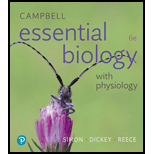
An atom can be changed into an ion by adding or removing _____. An atom can be changed into a different isotope by adding or removing________.
To determine: The sub-atomic particles whose addition or subtraction can give rise to an ion and an isotope.
Introduction:
The atom is the smallest unit of biological organization. However, there are particles even smaller than an atom and that together make up the atom. These sub-atomic particles include protons, neutrons, and electrons. In the center of an atom, the nucleus is present, which is composed of protons (positively charged particles) and neutrons (neutral particles). Electrons (negatively charged particles) revolve around the nucleus in designated orbitals.
Answer to Problem 1SQ
Correct answer: An atom can be changed into an ion by adding or removing electrons. An atom can be changed into a different isotope by adding or removing neutrons.
Explanation of Solution
An ion is a charged particle formed by the atoms to attain stability. Atoms can either form a positively charged ion called a cation or a negatively charged ion called an anion. Ions are formed by the change in the number of electrons. If electrons are lost, the positive charge on the atom increases and it forms a cation. If electrons are gained by the atom, the atom gets negatively charged and forms an anion. For example, the sodium (
Isotopes are variants of the same element but with different mass. The mass of an atom is composed of the masses of protons and neutrons in the nucleus. If the number of protons is changed, the element will change. Thus, for the formation of an isotope, the number of neutrons is supposed to change. For example, the isotopes of hydrogen (zero neutrons) include protium (zero neutrons), deuterium (one neutron) and tritium (two neutrons).
To form an ion, the number of electrons is supposed to be changed and to form an isotope, the number of neutrons is supposed to change.
Want to see more full solutions like this?
Chapter 2 Solutions
Campbell Essential Biology with Physiology (6th Edition)
Additional Science Textbook Solutions
HUMAN ANATOMY
Genetics: From Genes to Genomes
Campbell Essential Biology (7th Edition)
Physical Science
Laboratory Manual For Human Anatomy & Physiology
- 3) Which statement(s) about the Pacific Decadal Oscillation (PDO) is/are TRUE? CIRCLE ALL THAT APPLY. A. It is a major driver of salmon populations in the Pacific B. It affects sea surface temperatures in the eastern Pacific C. Its cycles typically do not last as long as those of ENSO D. Evidence that it has occurred over many centuries has been gathered from tree ring dataarrow_forward4.arrow_forward2arrow_forward
- 1. 2. 3. Marine fish cells are hypotonic compared to their seawater environment; their cells lose water by osmosis and gain solutes. If you add heterotrophic respiration and autotrophic respiration together and then subtract that value from gross primary productivity, then you have a more refined estimate of ecosystem carbon storage than NEE. Differential heating due to the earth's tilt generates the global wind AND oceanic circulation patternsarrow_forward1arrow_forwardCan you please simply explain what is going on here.arrow_forward
- Does it show the level of proteins? What about the amount? Levels of protein activation? How can you tell? Does the thickness tell you anything? What about the number of the lines? And the other questionsarrow_forwardKD 200- 116- 66- Vec ATF6 (670) ATF6 (402) ATF6 (373) ATF6 (366) I I 45- 1 2 3 4 5 ATFG (360) (e/c) 9V ATFG (402) g ant- ATF anti-KDEL DAPI barrow_forwardWestern blot results: what information can you get? Presence of proteins of your interest Levels of protein expression Levels of protein activation (must use activation state-specific antibody) Decreased function of the ATM kinase in aging mice. A C57BL/6 female 6 month Con IR 20 month C57BL/6 male 6 month 28 month Con IR Con IR Con IR p-ATM (S1981) ATM P-p53 (ser18) Actinarrow_forward
 Concepts of BiologyBiologyISBN:9781938168116Author:Samantha Fowler, Rebecca Roush, James WisePublisher:OpenStax College
Concepts of BiologyBiologyISBN:9781938168116Author:Samantha Fowler, Rebecca Roush, James WisePublisher:OpenStax College
 Biology Today and Tomorrow without Physiology (Mi...BiologyISBN:9781305117396Author:Cecie Starr, Christine Evers, Lisa StarrPublisher:Cengage Learning
Biology Today and Tomorrow without Physiology (Mi...BiologyISBN:9781305117396Author:Cecie Starr, Christine Evers, Lisa StarrPublisher:Cengage Learning Biology 2eBiologyISBN:9781947172517Author:Matthew Douglas, Jung Choi, Mary Ann ClarkPublisher:OpenStax
Biology 2eBiologyISBN:9781947172517Author:Matthew Douglas, Jung Choi, Mary Ann ClarkPublisher:OpenStax





